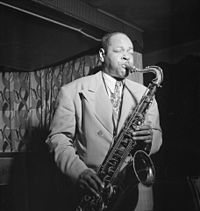Get happy
Get Happy is a song composed in 1929 by Ted Koehler (lyrics) and Harold Arlen (music) and first performed by Ruth Etting in the Nine-Fifteen Revue . After first publications in 1930, it became the jazz standard from the 1940s and was covered by many performers across all styles .

History of creation and world premiere
Arlen's composition in 32 bars in the form AABA was created during rehearsals for Vincent Youmans ' musical Great Day , for which Arlen was engaged as rehearsal pianist. On the mediation of the song hunter Harry Warren, Arlen played the song Ted Koehler, who realized that he was influenced by the song of the same name in the gospel music tradition; this song contained the repeating rhythmic phrase
- "My soul got happy this morning
- My soul got happy this morning, Lord "
which took up the experience of the Holy Spirit during the service. He wrote a text that brought the confident character of the melody, moving almost exclusively in major, to the motto Get Happy : "Sing alleluia, join in, be happy, be ready for judgment day".
Ruth Etting then sang it in 1930 on the less successful Broadway show The Nine-Fifteen Revue , but never took it on.
After Arlen and Koehler introduced Get Happy to the music publisher Piantadosi, Arlen received a contract as a composer and the then relatively high salary of 50 dollars a week in addition to his royalties . A number of other songs were created in collaboration with Koehler. The publisher Remick released the song as sheet music with Ruth Etting on the cover, whereupon it was soon discovered by other musicians.
Record recordings
In early 1930, further vocal versions were written, in April by Nat Shilkret and the Victor Orchestra, with which he reached position 6 in the charts; on May 10th he was recorded by Frankie Trumbauer & His Orchestra for Okeh with Joe Venuti and Eddie Lang and reached # 15 on the US hit parade. In 1932, an instrumental version was recorded in a hot jazz arrangement by Abe Lyman 's Brunswick Recording Orchestra, which then served as the theme tune for the Warner Bros. cartoon Merrie Melodies .
The song became popular in the United States through the interpretation of Judy Garland , who sang it in her last MGM film Summer Stock in 1950 and reinvigorated interest in the song. Although the early hit versions included vocals, it became popular primarily as an instrumental piece through the 1940s. The chorus produced an effective dramatic effect; the sermon-like lyrics contained the lines
- "Pack up your troubles, c'mon get happy" and
- "The Lord is waiting to take your hand,
- we're going to the Promised Land. "
The song and became a popular jazz standard . a. by interpretation by the Coleman Hawkins Swing Four for Signature Records , which recorded it on December 23, 1943 with Oscar Pettiford , Eddie Heywood and Shelly Manne . Another famous jazz version is by Red Norvo and his sextet with Dizzy Gillespie and Charlie Parker ( Move!, 1945). The song also served Bud Powell as a starting point for her improvisations.
Other versions were made by JJ Johnson with the Modern Jazz Quartet and Clifford Brown ( The Eminent Jay Jay Johnson , 1953) as well as by June Christy , Jimmy Smith (1956), Sonny Rollins (1957), Mal Waldron (1959), Johnny Dankworth , Ella Fitzgerald ( Ella Fitzgerald Sings the Harold Arlen Songbook , 1961), Bud Powell ( Jazz Giant , 1950), Frank Sinatra ( Swing Easy!, 1954), and more recently by Brad Mehldau and Rufus Wainwright .
literature
- Carlo Bohländer , Karl Heinz Holler, Christian Pfarr: Reclam's Jazz Guide . 5th, revised and supplemented edition. Reclam, Stuttgart 2000, ISBN 3-15-010464-5 .
- Hans-Jürgen Schaal (Ed.): Jazz standards. The encyclopedia. Bärenreiter, Kassel u. a. 2001, ISBN 3-7618-1414-3 .
Web links
Individual evidence
- ^ Carlo Bohländer: Reclam's Jazz Guide. Reclam, Stuttgart 2000.
- ↑ Lyrics by Negro spirituals
- ↑ Song portrait at Jazzstandards.com
- ↑ Hans-Jürgen Schaal, Jazz-Standards , p. 164f.
- ^ SA Music The Official Harold Arlen Website , 2001-2002 .
- ↑ a b c Detailed portrait of the song at Wicn.org ( Memento of the original from June 27, 2010 in the Internet Archive ) Info: The archive link has been inserted automatically and has not yet been checked. Please check the original and archive link according to the instructions and then remove this notice.
- ^ Gerhard Klußmeier: Jazz in the Charts. Another view on jazz history. Liner notes and booklet for the 100 CD edition. Membrane International GmbH. ISBN 978-3-86735-062-4
